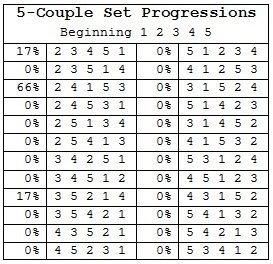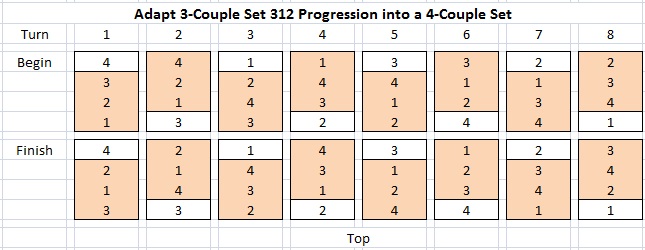
| Volume 31 #4 | January/February 2015 | |
The Manual of Scottish Country Dancing states, "An important feature of the longwise country dance is that it is usually progressive. After each turn of the dance, the couple at the top, who begin the dance, finish one place further down, although in some dances there is a different order of progression. Each of the other couples in succession, having reached the top, take their turn as leading couple." The Manual goes on to describe the most frequent forms of progression for two-couple dances in four-couple sets, three-couple dances in three-couple sets, three-couple dances in four-couple sets, four-couple dances in four-couple sets, and five-couple dances in five-couple sets.
I thought it would be interesting to consider progression from a mathematical permutation viewpoint and list all possible forms of progression. The exercise assumes partners remain together for each turn of a dance (although they may finish on opposite sides), couples finish each dance turn in a different place, and all couples effectively return to original places only after the final turn.
We are most familiar with two-couple and three-couple dances in which the leading couple progress down the set to "repeat, having passed a couple", while one or more couples are idle at the bottom or top, for a total of eight turns. The leading couple progress to the bottom or else step to the bottom after their final turn. We can number the couples and denote how couples change places: 1 2 3 4 -> 2 1 3 4 -> 2 3 1 4.
The other type of progression has all couples dancing each turn, with the number of turns equal to the number of couples. We have a valid progression as long as each couple move to a new place and all couples move to all places during the turns of a dance. An example of an invalid progression is 1 2 3 4 -> 2 1 4 3, because although each couple move to a new place, the couples only begin in two different places during four turns.
The three-couple dance in a three-couple set can finish in six permutations, equals 3 x 2 x 1, and two of the six permutations are a valid progression.
I surveyed progression frequencies of dances in the RSCDS Index to Scottish Country Dances
https://www.rscds.org/document/762. We are most
familiar with 1st couple finishing at the bottom (79%):
1 2 3 -> 2 3 1. The progression may also run in reverse with 3rd couple finishing
at the top (21%): 1 2 3 -> 3 1 2.

The four-couple dance in a four-couple set can finish in 24 permutations, equals 4 x 3 x 2 x 1, and 6 of the 24 permutations are a valid progression. The six progressions are three pairs which are the reverse of each other. The frequencies of progression in the RSCDS index are:

The five-couple dance in a five-couple set can finish in 120 permutations, equals 5 x 4 x 3 x 2 x 1, and 24 of the 120 permutations are a valid progression. The 24 progressions are 12 pairs which are the reverse of each other. The frequencies of progression in the RSCDS index are:

In dances with the most frequent progression 1 2 3 4 5 -> 2 4 1 5 3, 1st and 3rd couples begin the dance and travel similar tracks with supporting couples below them. Three-couple dances with progression 1 2 3 -> 2 3 1 and with 3rd couple stationary at the right times can be adapted into such a five-couple dance with this progression.
We can adapt the three-couple-dance 3 1 2 reverse progression into a four-couple set with "repeat, having passed a couple." Since 3rd couple progress to first place and 1st couple progress to second place, 1st couple pass 3rd couple instead of passing 2nd couple: 1 2 3 4 -> 3 1 2 4 -> 3 4 1 2. We can observe each turn of dancer positions in the table.

The tables show several progressions with low or zero percentage dance frequencies. Dance devisers who are aware of the progression possibilities might imagine new dances with an unusual progression.